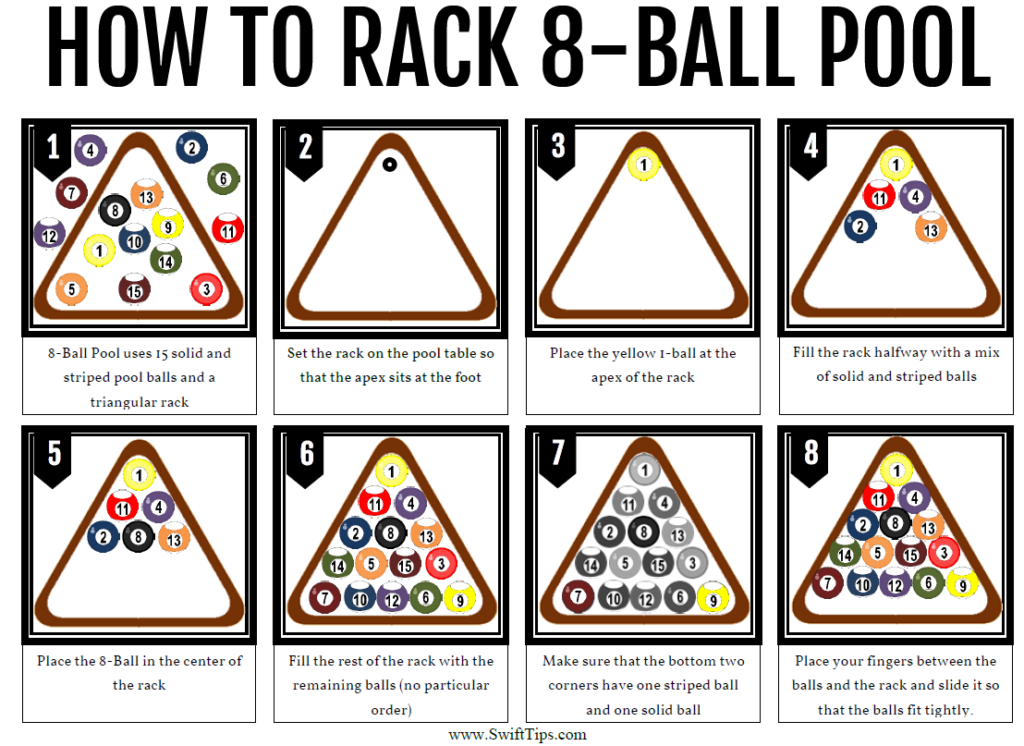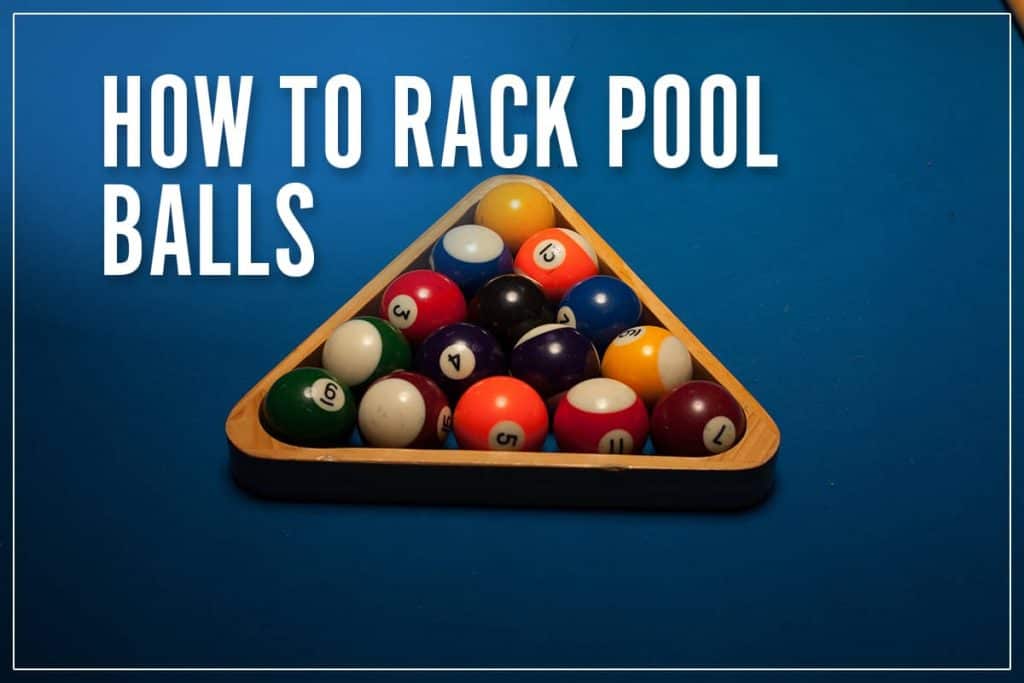Ever watched a pool game and wondered what that ritualistic triangle setup is all about? Mastering the art of the rack is paramount to achieving a consistent, powerful break, ultimately elevating your entire game.
The way you arrange those balls before the break shot isn't just a formality; it's a subtle science that can significantly influence the game's trajectory. A well-executed rack ensures that the balls are tightly packed, maximizing energy transfer upon impact and promoting a more even spread across the table. Conversely, a poorly racked set can lead to weak breaks, clustered balls, and missed opportunities. The devil is truly in the details when it comes to setting up the perfect pool game.
| Aspect | Details |
|---|---|
| Keyword Term | How to rack pool balls (Noun Phrase) |
| Related Equipment | Standard set of billiard or pool balls (16 balls), Triangle rack |
| General Racking Principle | Moving the balls efficiently and positioning them precisely within the corners of the triangle is key. |
| Importance of a Tight Rack | A tight rack is essential for a perfect break and to ensure the highest quality of the game. |
| Impact of Poor Racking | Can lead to weak breaks, clustered balls, and missed opportunities. |
| Standard Rack Shape | Triangle for 8-ball, Straight Pool, American Pool; Diamond for 9-ball. |
| Apex Ball Position | Apex ball is placed on the foot spot. |
| Ball Placement Consideration | Spread the balls randomly to prevent clustering; avoid placing a solid or stripe ball next to each other in a row. |
| Racking Objective | Achieve a tight, solid rack for a predictable and powerful break. |
| Governing Body Influence | Racking requirements can vary depending on the governing body. |
| Skill Level | This is the basic skill for beginners to learn and practice. |
| Reference Website | Billiards at Colorado State University |
So, how do you transform a seemingly simple task into a game-enhancing skill? It begins with understanding the fundamental equipment and principles involved. You'll need a standard set of billiard or pool balls, typically 16 in total (including the cue ball), and a triangle rack specifically designed for the game you're playing. While most pool games utilize a triangular rack, variations like 9-ball employ a diamond formation due to the reduced number of object balls.
The initial step involves placing the racking triangle in position along the foot string of the table, carefully centering it so that the top of the triangle aligns perfectly with the foot spot. This is a crucial reference point that ensures consistency and fairness throughout the game. Before loading the balls, take a moment to slide the rack across the table's surface, verifying that the apex ball (the ball at the triangle's point) rests precisely on the foot spot. Any misalignment here can throw off the entire break.
With the rack properly positioned, it's time to arrange the object balls. For most standard pool games, the objective is to create a random yet balanced configuration. Avoid clustering solids or stripes together in a row, as this can lead to predictable break patterns and limit your strategic options. Instead, strive for a heterogeneous distribution that promotes a more dynamic and unpredictable outcome. One commonly employed technique is to alternate solids and stripes along the triangle's base, ensuring a more even spread across the playing surface.
The placement of the 8-ball in 8-ball pool is a key aspect of racking. The 8-ball should be positioned in the middle of the triangle. This placement adds an element of strategy to the break, as players must consider the potential consequences of pocketing the 8-ball prematurely.
- New Web Series Movies What To Watch Date Streaming Guide
- Justina Valentine Bio Zodiac Wild N Out More Facts
Once the balls are arranged within the rack, the real test begins. The goal is to create a tightly packed formation where each ball is in contact with its neighbors. This maximizes the transfer of energy upon impact, resulting in a more powerful and effective break. Gently but firmly push the balls together, ensuring that there are no visible gaps or spaces within the rack.
Achieving this level of tightness often requires a delicate touch and a keen eye for detail. Slight adjustments may be necessary to eliminate any lingering gaps or inconsistencies. Some players even employ a subtle "tapping" technique, using a soft object to gently nudge the balls into a more compact configuration. The key is to avoid excessive force, which can disrupt the arrangement and compromise the overall tightness of the rack.
With the balls securely packed, it's time to remove the rack. This is a critical step that can either solidify your efforts or undo all your hard work. The ideal technique involves a smooth, controlled, and upward motion. Apply gentle pressure to the balls while simultaneously lifting the rack, minimizing any potential for movement or displacement. For best results, push the balls firmly forward as you remove the rack, ensuring that they maintain their tight formation.
Once the rack is removed, take a moment to visually inspect the arrangement. Confirm that the balls remain tightly packed and that the apex ball is still precisely positioned on the foot spot. Any signs of looseness or misalignment should be addressed immediately. A quick nudge or adjustment may be all that's needed to restore the integrity of the rack.
The importance of proper racking cannot be overstated. A well-executed rack not only enhances the quality of the game but also promotes fairness and consistency. By adhering to these techniques and paying close attention to detail, you can transform a seemingly mundane task into a skill that elevates your entire pool-playing experience.
But pool isn't a monolith. Different pool games have their own racking quirks. For instance, in straight pool, the racking process is unique. Unlike 8-ball or 9-ball, straight pool doesn't demand a specific order for ball placement. Because the game continues with whichever balls remain on the table after each rack, there is no single pattern to follow. The 15 balls are simply placed within the triangle, ready for the next frame.
The absence of a specific racking order in straight pool stems from the nature of the game itself. Since the goal is to continuously pocket balls and accumulate points, the specific arrangement of the balls at the beginning of each rack is less critical than in other variations. The focus shifts to strategic shot selection and positional play, as players navigate the evolving layout of the table.
In cutthroat pool, a game where players compete against each other to avoid pocketing certain balls, racking also takes on a strategic dimension. If your opponent is about to break, you can try to rack the balls extra tightly. A tightly packed rack makes it harder for the balls to scatter widely, potentially limiting your opponent's break and giving you a slight advantage.
This strategy relies on the physics of impact. When the balls are packed tightly, the force of the cue ball is distributed more evenly, reducing the likelihood of a dramatic spread. While it won't guarantee a defensive advantage, a tight rack can certainly make your opponent's break more challenging.
Cutthroat pool also involves a specific ball arrangement. One suggested method is to place one ball in the fifth and first row, two balls in the fourth and second rows, and three balls in the third row. Furthermore, the ball in the apex corner can be either a spot or a stripe, unlike British pool, where the 8-ball holds this position. In cutthroat, the 8-ball is placed behind this apex ball, with the rest of the balls arranged randomly.
In the realm of American pool, where spots and stripes dominate the landscape, racking follows specific guidelines. The general rules dictate that the balls are racked in a triangle shape with the apex ball positioned on the foot spot. The rack should be tight, with each ball touching its neighbors, ensuring optimal energy transfer upon impact.
Then there's 9-ball pool, known for its fast-paced action and strategic complexity. Because 9-ball pool employs exactly nine object balls, racking requires a diamond formation rather than the traditional triangle. The primary objective of the game is to pocket the 9-ball, adding an extra layer of strategic importance to the break.
The diamond formation in 9-ball pool typically places the 1-ball at the apex, positioned on the foot spot, with the 9-ball located in the center of the diamond. The remaining balls are arranged randomly, creating a dynamic layout that encourages creative shot-making and tactical maneuvering.
In summary, mastering the art of racking pool balls is an essential skill for any serious player. Whether you're playing 8-ball, straight pool, cutthroat, or 9-ball, understanding the nuances of racking can significantly impact your game. By following these tips and techniques, you can ensure a tight, solid rack every time, setting the stage for a powerful break and a successful game.
- Toni Kroos The Legend Retirement Footballing Achievements
- Cue Tip For Draw Find Your Best Shot Pro Tips


